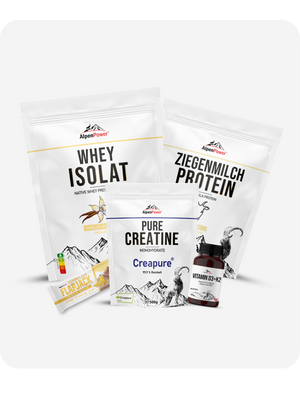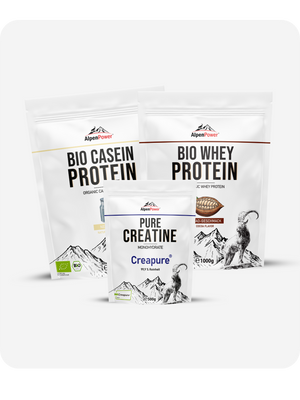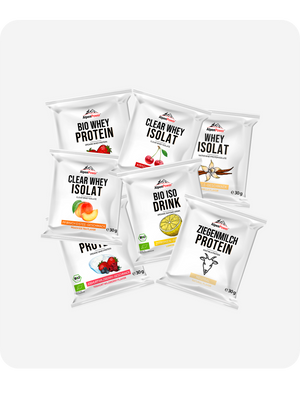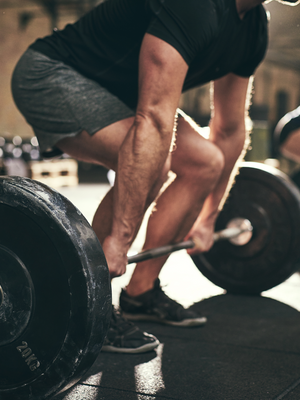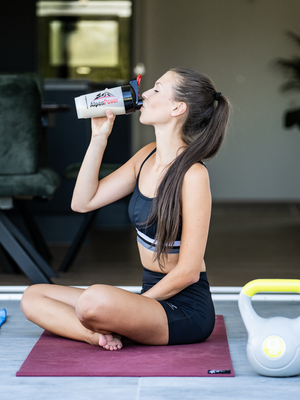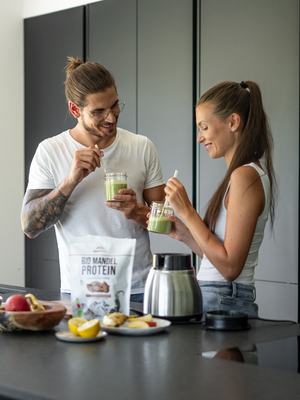Building muscle takes more than training. Here you can find out how biological proteins, timing and meal structure make the difference.
Protein strategies for building muscle: optimizing meals with organic ingredients
An article by Denis Waßmann - athlete since 1996, supplement expert and founder of kraftmahl.de
Muscle building begins in training - it is decided on the plate. If you train hard, you need a clear strategy to give your body what it needs for regeneration, growth and performance. Proteins are at the heart of this. But not every protein is the same - and certainly not every meal.
In this article, we will show you how to distribute your protein intake throughout the day, what differences organic raw materials make in everyday life - and what you should look out for if you don't want to leave your progress to chance.
Not all proteins are the same - what really matters
It is not only the amount of protein that is crucial for muscle building, but also the composition of the amino acids - especially the essential amino acids (EAAs). These must be supplied through food because the body cannot produce them itself. Particularly important: leucine - it is considered the trigger for muscle protein synthesis.
Organic animal proteins such as whey, egg or yoghurt contain a complete amino acid profile. Plant proteins usually have to be combined for an optimal amino acid profile - for example rice with peas. The decisive factor is bioavailability: in other words, how much of the protein actually reaches the muscles - not just on the label, but in the cell.
Why organic really matters - and isn't just a marketing term
Organic does not equal "healthy" - but in the case of proteins, it can be a clear quality advantage. When it comes to animal products, how the animals are fed plays a major role. Were cows fed with GMO-free organic feed? Were antibiotics avoided? Was the protein processed gently?
In the case of plant proteins, it's all about freedom from residues (e.g. pesticides), traceability of origin - and gentle extraction processes. With hemp proteins, sunflower proteins or pumpkin seed proteins in particular, this can mean big differences in tolerability and nutritional value.
The right timing - how to plan meals around training
Before training:
Whether you need a shake before training depends on when and what you last ate. If your last protein-rich meal was more than 3 hours ago, a small pre-workout snack may be useful. This is not about maximum calorie intake, but about an easily digestible combination of some protein and fast carbohydrates - e.g. half a whey shake with banana or some rice cakes with almond butter. You should avoid proteins that are difficult to digest, such as rice protein or larger portions.
After training:
The anabolic window is larger than often claimed. If you have already had a protein-rich meal before training, there is no time pressure for the shake afterwards. For optimal results and to support recovery, it is important that you consume protein again over the next few hours - preferably in the form of a full meal or a high-quality shake. You don't necessarily need carbohydrates directly after training, but they can help to replenish your glycogen stores more quickly - especially if you train several times a day or generally do a high volume of training.
Throughout the day: The basis should be wholesome meals with high-quality protein sources. Cottage cheese with linseed oil, eggs, tempeh or lentil dishes - anything that combines protein with micronutrients has its place here.
Example of a balanced nutrition day
|
Meal |
Protein source |
Goal |
|
Breakfast |
Oat flakes with organic whey and nuts |
Muscle building + satiety |
|
Snack |
Organic protein bar or shake |
Supply in between |
|
Lunch |
Quinoa, lentils, tofu, vegetables |
Long-chain proteins + micronutrients |
|
Pre-workout |
Banana + Whey drink |
Fast energy + EAAs |
|
Post-workout |
Shake with AlpenPower organic whey or rice protein |
Regeneration |
|
Dinner |
Tempeh, oven vegetables, hemp oil |
Plant variety + satiety |
Common mistakes - and how you can do better
- Just paying attention to the quantity is not enough: even 150 g of protein is of little use if it is only spread over two meals. To regularly activate muscle protein synthesis throughout the day, you should consume around 20-40g of high-quality protein every 3-5 hours. This way you can use the effect of every meal for your progress - not just the daily balance.
- One-sided sources: Just whey or just tofu is not enough. The combination of different proteins and foods brings better results.
- No adaptation to training days: Rest days need fewer carbohydrates, but still a constant protein intake - otherwise regeneration stagnates.
Extra: Bioavailability, satiety and digestion - underestimated factors
Whey has a very high biological value (approx. 104), but is digested quickly - ideal directly after training. Casein releases amino acids more slowly - perfect for longer supplies (e.g. in the evening and overnight).
Vegetable proteins are usually more filling - mainly due to the fiber they contain. This can be beneficial during a diet phase, but during the build-up phase care should be taken to ensure sufficient calorie intake.
Conclusion: smart planning saves you having to take steps backwards
Muscle building is not a product of chance. Those who specifically incorporate organic raw materials into a functional meal structure benefit from better regeneration, more energy during training and more sustainable progress. Organic is not an end in itself - but a building block for real quality.
So if you're already training hard: give your body the nutrients it deserves.
Author: Denis Waßmann
